Achieving Cultural Safety in Healthcare: A Comprehensive Analysis
VerifiedAdded on 2023/03/31
|9
|2217
|342
Essay
AI Summary
This essay provides a comprehensive overview of cultural safety in healthcare, with a specific focus on its application to Indigenous Australians. It begins by highlighting organizations like Danila Dilba Health Service that aim to improve health outcomes and well-being within Aboriginal and Torres Strait Islander communities. The essay discusses the concept of cultural safety, emphasizing its importance in addressing historical and social contexts, power imbalances, and healthcare injustices. It examines how cultural safety differs from cultural awareness and sensitivity, advocating for healthcare organizations to actively dismantle barriers to culturally appropriate and effective care. The essay further explores the need for equity in healthcare access, citing research that reveals disparities in treatment for Indigenous individuals. It concludes by stressing the importance of collaboration between Indigenous communities and healthcare providers to achieve culturally acceptable solutions and improve overall health outcomes, promoting the idea that Indigenous populations must actively engage in their healthcare to foster positive change. Desklib offers a variety of resources including similar essays and study tools.
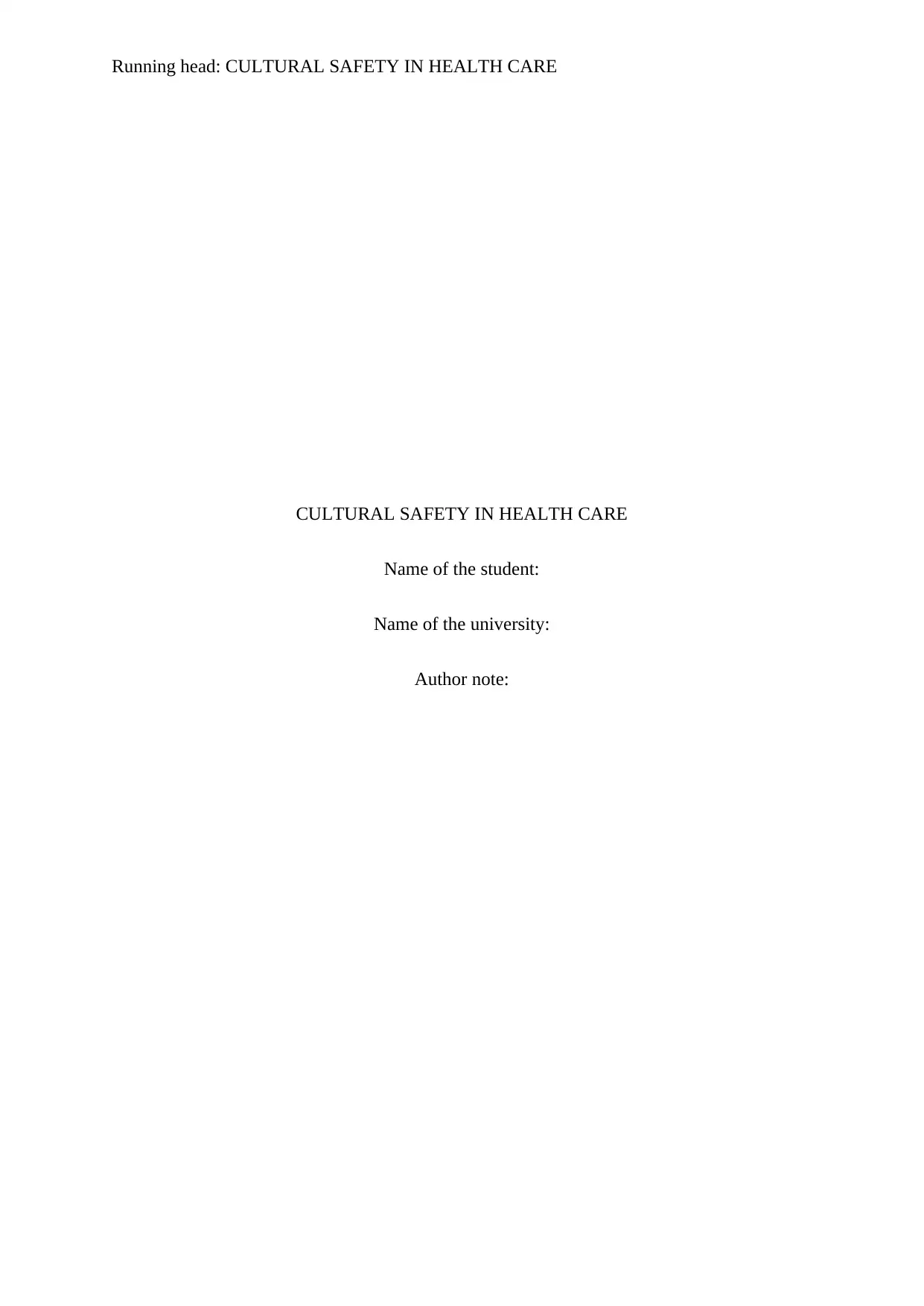
Running head: CULTURAL SAFETY IN HEALTH CARE
CULTURAL SAFETY IN HEALTH CARE
Name of the student:
Name of the university:
Author note:
CULTURAL SAFETY IN HEALTH CARE
Name of the student:
Name of the university:
Author note:
Paraphrase This Document
Need a fresh take? Get an instant paraphrase of this document with our AI Paraphraser
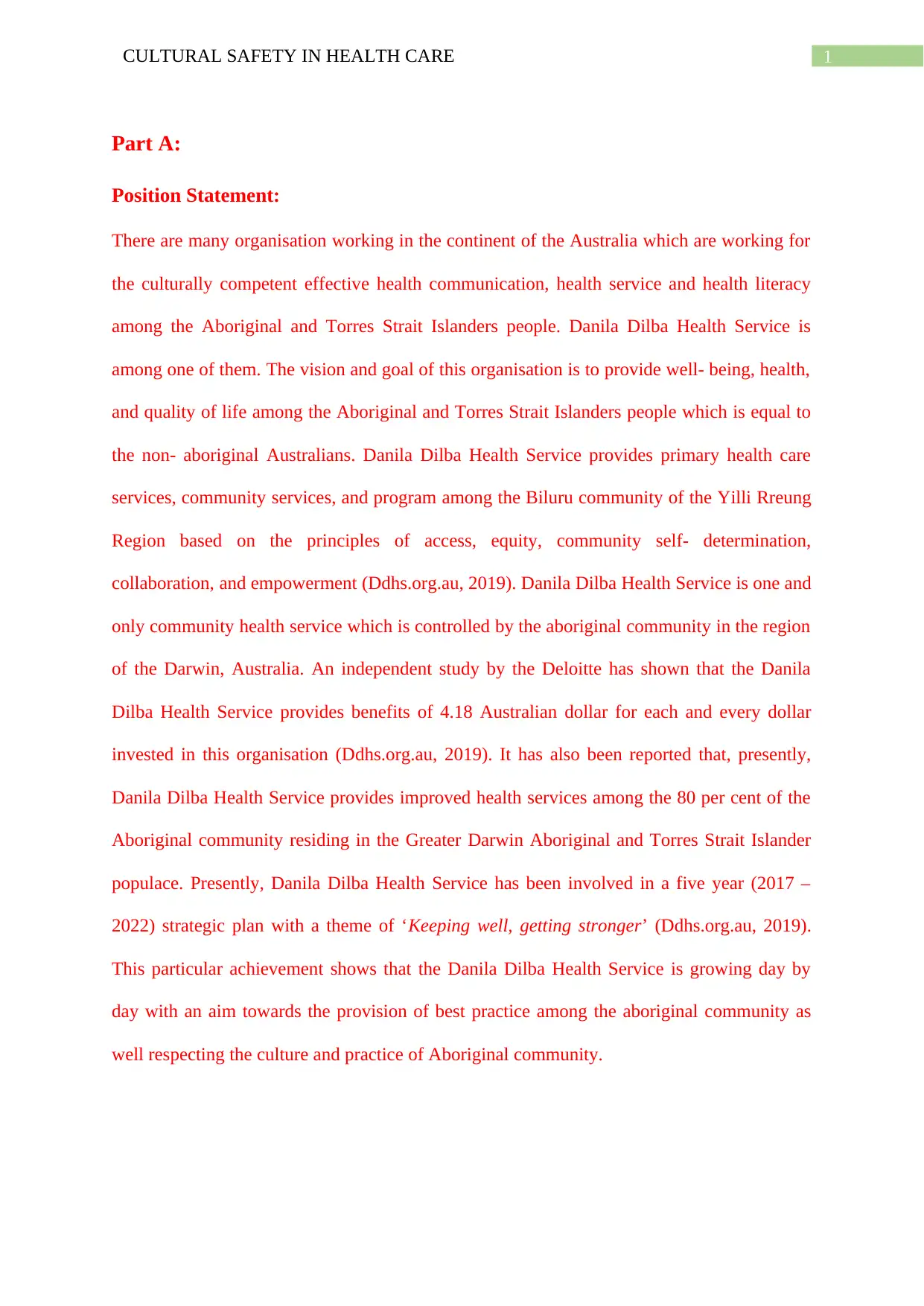
1CULTURAL SAFETY IN HEALTH CARE
Part A:
Position Statement:
There are many organisation working in the continent of the Australia which are working for
the culturally competent effective health communication, health service and health literacy
among the Aboriginal and Torres Strait Islanders people. Danila Dilba Health Service is
among one of them. The vision and goal of this organisation is to provide well- being, health,
and quality of life among the Aboriginal and Torres Strait Islanders people which is equal to
the non- aboriginal Australians. Danila Dilba Health Service provides primary health care
services, community services, and program among the Biluru community of the Yilli Rreung
Region based on the principles of access, equity, community self- determination,
collaboration, and empowerment (Ddhs.org.au, 2019). Danila Dilba Health Service is one and
only community health service which is controlled by the aboriginal community in the region
of the Darwin, Australia. An independent study by the Deloitte has shown that the Danila
Dilba Health Service provides benefits of 4.18 Australian dollar for each and every dollar
invested in this organisation (Ddhs.org.au, 2019). It has also been reported that, presently,
Danila Dilba Health Service provides improved health services among the 80 per cent of the
Aboriginal community residing in the Greater Darwin Aboriginal and Torres Strait Islander
populace. Presently, Danila Dilba Health Service has been involved in a five year (2017 –
2022) strategic plan with a theme of ‘Keeping well, getting stronger’ (Ddhs.org.au, 2019).
This particular achievement shows that the Danila Dilba Health Service is growing day by
day with an aim towards the provision of best practice among the aboriginal community as
well respecting the culture and practice of Aboriginal community.
Part A:
Position Statement:
There are many organisation working in the continent of the Australia which are working for
the culturally competent effective health communication, health service and health literacy
among the Aboriginal and Torres Strait Islanders people. Danila Dilba Health Service is
among one of them. The vision and goal of this organisation is to provide well- being, health,
and quality of life among the Aboriginal and Torres Strait Islanders people which is equal to
the non- aboriginal Australians. Danila Dilba Health Service provides primary health care
services, community services, and program among the Biluru community of the Yilli Rreung
Region based on the principles of access, equity, community self- determination,
collaboration, and empowerment (Ddhs.org.au, 2019). Danila Dilba Health Service is one and
only community health service which is controlled by the aboriginal community in the region
of the Darwin, Australia. An independent study by the Deloitte has shown that the Danila
Dilba Health Service provides benefits of 4.18 Australian dollar for each and every dollar
invested in this organisation (Ddhs.org.au, 2019). It has also been reported that, presently,
Danila Dilba Health Service provides improved health services among the 80 per cent of the
Aboriginal community residing in the Greater Darwin Aboriginal and Torres Strait Islander
populace. Presently, Danila Dilba Health Service has been involved in a five year (2017 –
2022) strategic plan with a theme of ‘Keeping well, getting stronger’ (Ddhs.org.au, 2019).
This particular achievement shows that the Danila Dilba Health Service is growing day by
day with an aim towards the provision of best practice among the aboriginal community as
well respecting the culture and practice of Aboriginal community.
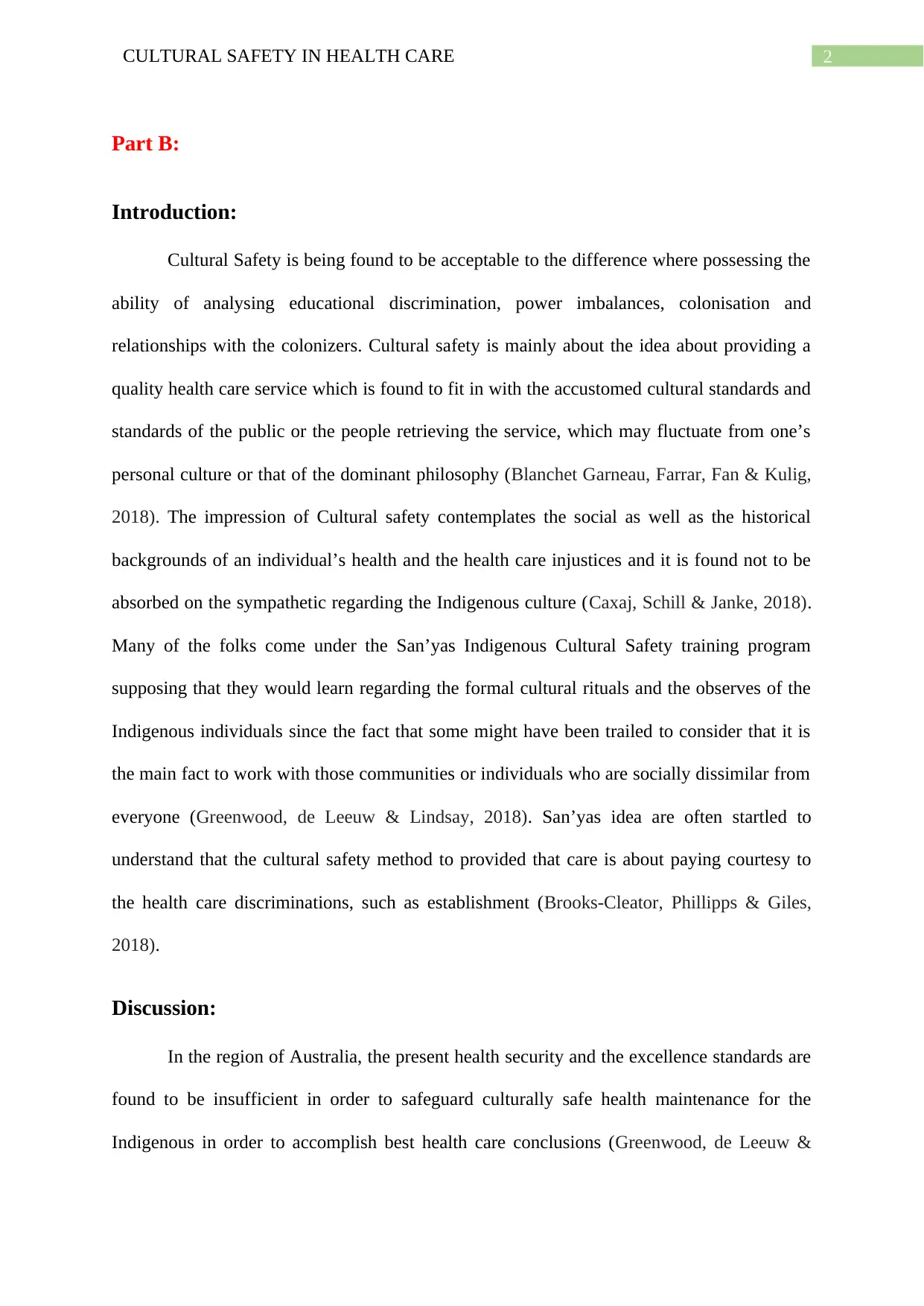
2CULTURAL SAFETY IN HEALTH CARE
Part B:
Introduction:
Cultural Safety is being found to be acceptable to the difference where possessing the
ability of analysing educational discrimination, power imbalances, colonisation and
relationships with the colonizers. Cultural safety is mainly about the idea about providing a
quality health care service which is found to fit in with the accustomed cultural standards and
standards of the public or the people retrieving the service, which may fluctuate from one’s
personal culture or that of the dominant philosophy (Blanchet Garneau, Farrar, Fan & Kulig,
2018). The impression of Cultural safety contemplates the social as well as the historical
backgrounds of an individual’s health and the health care injustices and it is found not to be
absorbed on the sympathetic regarding the Indigenous culture (Caxaj, Schill & Janke, 2018).
Many of the folks come under the San’yas Indigenous Cultural Safety training program
supposing that they would learn regarding the formal cultural rituals and the observes of the
Indigenous individuals since the fact that some might have been trailed to consider that it is
the main fact to work with those communities or individuals who are socially dissimilar from
everyone (Greenwood, de Leeuw & Lindsay, 2018). San’yas idea are often startled to
understand that the cultural safety method to provided that care is about paying courtesy to
the health care discriminations, such as establishment (Brooks-Cleator, Phillipps & Giles,
2018).
Discussion:
In the region of Australia, the present health security and the excellence standards are
found to be insufficient in order to safeguard culturally safe health maintenance for the
Indigenous in order to accomplish best health care conclusions (Greenwood, de Leeuw &
Part B:
Introduction:
Cultural Safety is being found to be acceptable to the difference where possessing the
ability of analysing educational discrimination, power imbalances, colonisation and
relationships with the colonizers. Cultural safety is mainly about the idea about providing a
quality health care service which is found to fit in with the accustomed cultural standards and
standards of the public or the people retrieving the service, which may fluctuate from one’s
personal culture or that of the dominant philosophy (Blanchet Garneau, Farrar, Fan & Kulig,
2018). The impression of Cultural safety contemplates the social as well as the historical
backgrounds of an individual’s health and the health care injustices and it is found not to be
absorbed on the sympathetic regarding the Indigenous culture (Caxaj, Schill & Janke, 2018).
Many of the folks come under the San’yas Indigenous Cultural Safety training program
supposing that they would learn regarding the formal cultural rituals and the observes of the
Indigenous individuals since the fact that some might have been trailed to consider that it is
the main fact to work with those communities or individuals who are socially dissimilar from
everyone (Greenwood, de Leeuw & Lindsay, 2018). San’yas idea are often startled to
understand that the cultural safety method to provided that care is about paying courtesy to
the health care discriminations, such as establishment (Brooks-Cleator, Phillipps & Giles,
2018).
Discussion:
In the region of Australia, the present health security and the excellence standards are
found to be insufficient in order to safeguard culturally safe health maintenance for the
Indigenous in order to accomplish best health care conclusions (Greenwood, de Leeuw &
⊘ This is a preview!⊘
Do you want full access?
Subscribe today to unlock all pages.

Trusted by 1+ million students worldwide
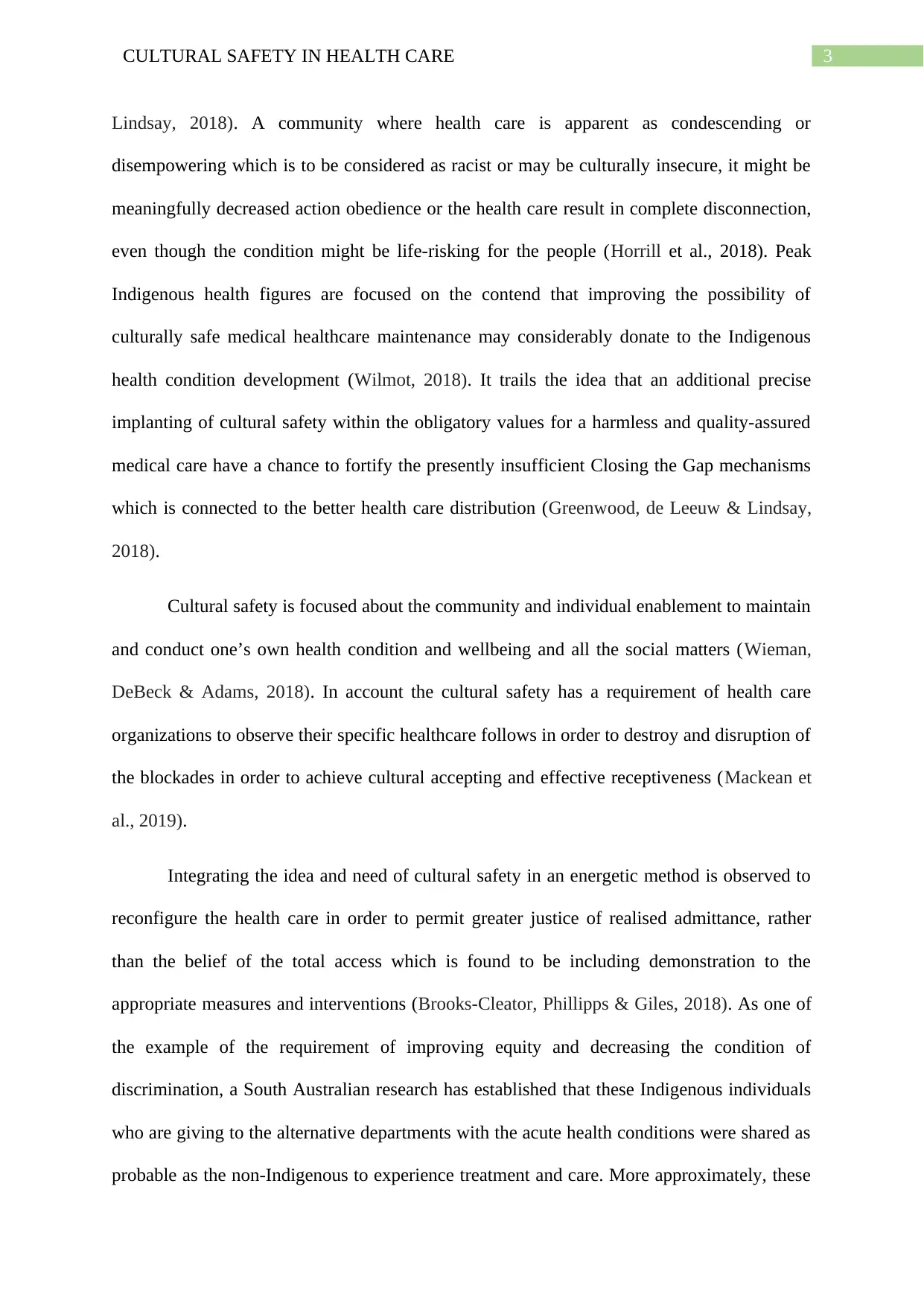
3CULTURAL SAFETY IN HEALTH CARE
Lindsay, 2018). A community where health care is apparent as condescending or
disempowering which is to be considered as racist or may be culturally insecure, it might be
meaningfully decreased action obedience or the health care result in complete disconnection,
even though the condition might be life-risking for the people (Horrill et al., 2018). Peak
Indigenous health figures are focused on the contend that improving the possibility of
culturally safe medical healthcare maintenance may considerably donate to the Indigenous
health condition development (Wilmot, 2018). It trails the idea that an additional precise
implanting of cultural safety within the obligatory values for a harmless and quality-assured
medical care have a chance to fortify the presently insufficient Closing the Gap mechanisms
which is connected to the better health care distribution (Greenwood, de Leeuw & Lindsay,
2018).
Cultural safety is focused about the community and individual enablement to maintain
and conduct one’s own health condition and wellbeing and all the social matters (Wieman,
DeBeck & Adams, 2018). In account the cultural safety has a requirement of health care
organizations to observe their specific healthcare follows in order to destroy and disruption of
the blockades in order to achieve cultural accepting and effective receptiveness (Mackean et
al., 2019).
Integrating the idea and need of cultural safety in an energetic method is observed to
reconfigure the health care in order to permit greater justice of realised admittance, rather
than the belief of the total access which is found to be including demonstration to the
appropriate measures and interventions (Brooks-Cleator, Phillipps & Giles, 2018). As one of
the example of the requirement of improving equity and decreasing the condition of
discrimination, a South Australian research has established that these Indigenous individuals
who are giving to the alternative departments with the acute health conditions were shared as
probable as the non-Indigenous to experience treatment and care. More approximately, these
Lindsay, 2018). A community where health care is apparent as condescending or
disempowering which is to be considered as racist or may be culturally insecure, it might be
meaningfully decreased action obedience or the health care result in complete disconnection,
even though the condition might be life-risking for the people (Horrill et al., 2018). Peak
Indigenous health figures are focused on the contend that improving the possibility of
culturally safe medical healthcare maintenance may considerably donate to the Indigenous
health condition development (Wilmot, 2018). It trails the idea that an additional precise
implanting of cultural safety within the obligatory values for a harmless and quality-assured
medical care have a chance to fortify the presently insufficient Closing the Gap mechanisms
which is connected to the better health care distribution (Greenwood, de Leeuw & Lindsay,
2018).
Cultural safety is focused about the community and individual enablement to maintain
and conduct one’s own health condition and wellbeing and all the social matters (Wieman,
DeBeck & Adams, 2018). In account the cultural safety has a requirement of health care
organizations to observe their specific healthcare follows in order to destroy and disruption of
the blockades in order to achieve cultural accepting and effective receptiveness (Mackean et
al., 2019).
Integrating the idea and need of cultural safety in an energetic method is observed to
reconfigure the health care in order to permit greater justice of realised admittance, rather
than the belief of the total access which is found to be including demonstration to the
appropriate measures and interventions (Brooks-Cleator, Phillipps & Giles, 2018). As one of
the example of the requirement of improving equity and decreasing the condition of
discrimination, a South Australian research has established that these Indigenous individuals
who are giving to the alternative departments with the acute health conditions were shared as
probable as the non-Indigenous to experience treatment and care. More approximately, these
Paraphrase This Document
Need a fresh take? Get an instant paraphrase of this document with our AI Paraphraser
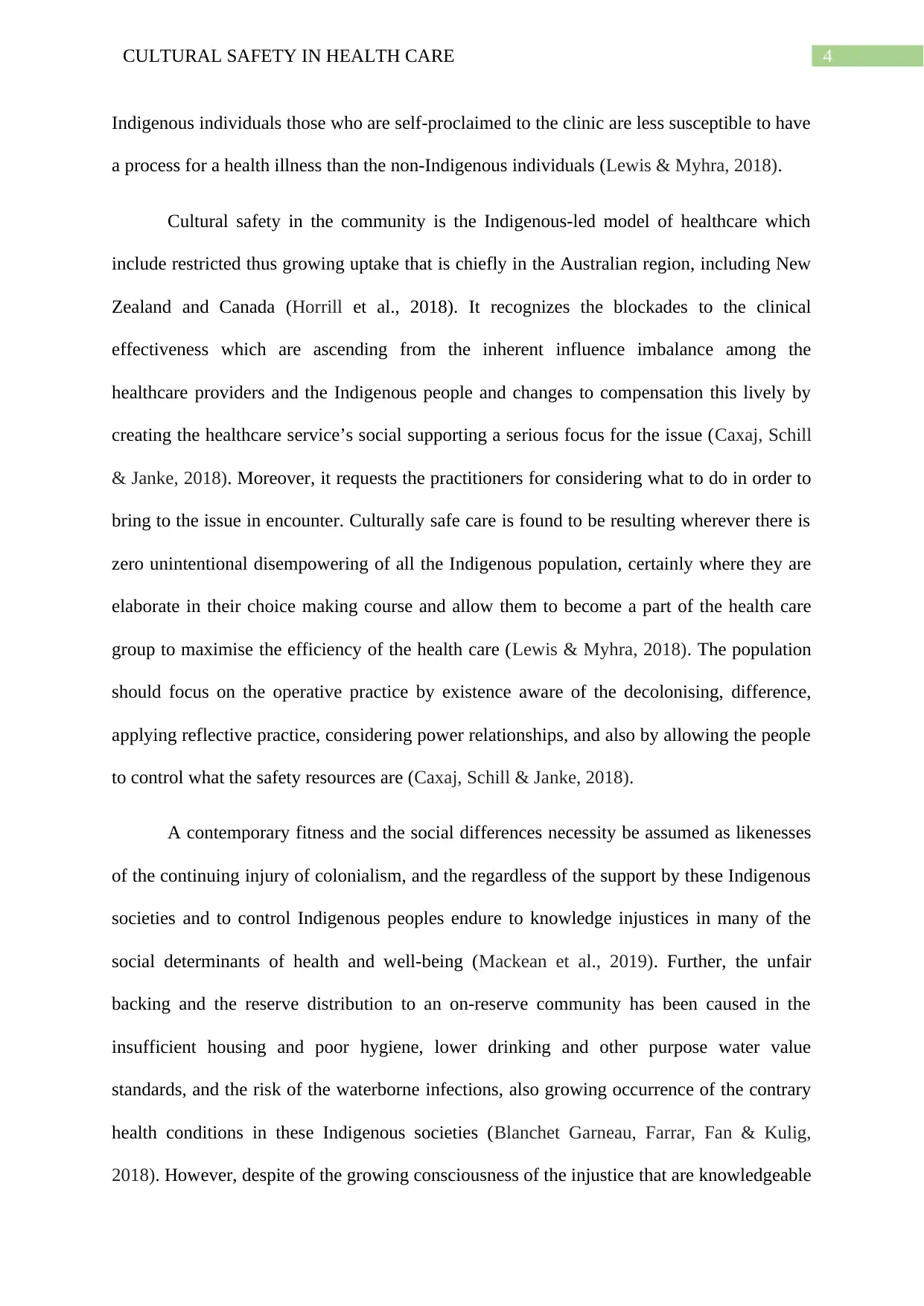
4CULTURAL SAFETY IN HEALTH CARE
Indigenous individuals those who are self-proclaimed to the clinic are less susceptible to have
a process for a health illness than the non-Indigenous individuals (Lewis & Myhra, 2018).
Cultural safety in the community is the Indigenous-led model of healthcare which
include restricted thus growing uptake that is chiefly in the Australian region, including New
Zealand and Canada (Horrill et al., 2018). It recognizes the blockades to the clinical
effectiveness which are ascending from the inherent influence imbalance among the
healthcare providers and the Indigenous people and changes to compensation this lively by
creating the healthcare service’s social supporting a serious focus for the issue (Caxaj, Schill
& Janke, 2018). Moreover, it requests the practitioners for considering what to do in order to
bring to the issue in encounter. Culturally safe care is found to be resulting wherever there is
zero unintentional disempowering of all the Indigenous population, certainly where they are
elaborate in their choice making course and allow them to become a part of the health care
group to maximise the efficiency of the health care (Lewis & Myhra, 2018). The population
should focus on the operative practice by existence aware of the decolonising, difference,
applying reflective practice, considering power relationships, and also by allowing the people
to control what the safety resources are (Caxaj, Schill & Janke, 2018).
A contemporary fitness and the social differences necessity be assumed as likenesses
of the continuing injury of colonialism, and the regardless of the support by these Indigenous
societies and to control Indigenous peoples endure to knowledge injustices in many of the
social determinants of health and well-being (Mackean et al., 2019). Further, the unfair
backing and the reserve distribution to an on-reserve community has been caused in the
insufficient housing and poor hygiene, lower drinking and other purpose water value
standards, and the risk of the waterborne infections, also growing occurrence of the contrary
health conditions in these Indigenous societies (Blanchet Garneau, Farrar, Fan & Kulig,
2018). However, despite of the growing consciousness of the injustice that are knowledgeable
Indigenous individuals those who are self-proclaimed to the clinic are less susceptible to have
a process for a health illness than the non-Indigenous individuals (Lewis & Myhra, 2018).
Cultural safety in the community is the Indigenous-led model of healthcare which
include restricted thus growing uptake that is chiefly in the Australian region, including New
Zealand and Canada (Horrill et al., 2018). It recognizes the blockades to the clinical
effectiveness which are ascending from the inherent influence imbalance among the
healthcare providers and the Indigenous people and changes to compensation this lively by
creating the healthcare service’s social supporting a serious focus for the issue (Caxaj, Schill
& Janke, 2018). Moreover, it requests the practitioners for considering what to do in order to
bring to the issue in encounter. Culturally safe care is found to be resulting wherever there is
zero unintentional disempowering of all the Indigenous population, certainly where they are
elaborate in their choice making course and allow them to become a part of the health care
group to maximise the efficiency of the health care (Lewis & Myhra, 2018). The population
should focus on the operative practice by existence aware of the decolonising, difference,
applying reflective practice, considering power relationships, and also by allowing the people
to control what the safety resources are (Caxaj, Schill & Janke, 2018).
A contemporary fitness and the social differences necessity be assumed as likenesses
of the continuing injury of colonialism, and the regardless of the support by these Indigenous
societies and to control Indigenous peoples endure to knowledge injustices in many of the
social determinants of health and well-being (Mackean et al., 2019). Further, the unfair
backing and the reserve distribution to an on-reserve community has been caused in the
insufficient housing and poor hygiene, lower drinking and other purpose water value
standards, and the risk of the waterborne infections, also growing occurrence of the contrary
health conditions in these Indigenous societies (Blanchet Garneau, Farrar, Fan & Kulig,
2018). However, despite of the growing consciousness of the injustice that are knowledgeable
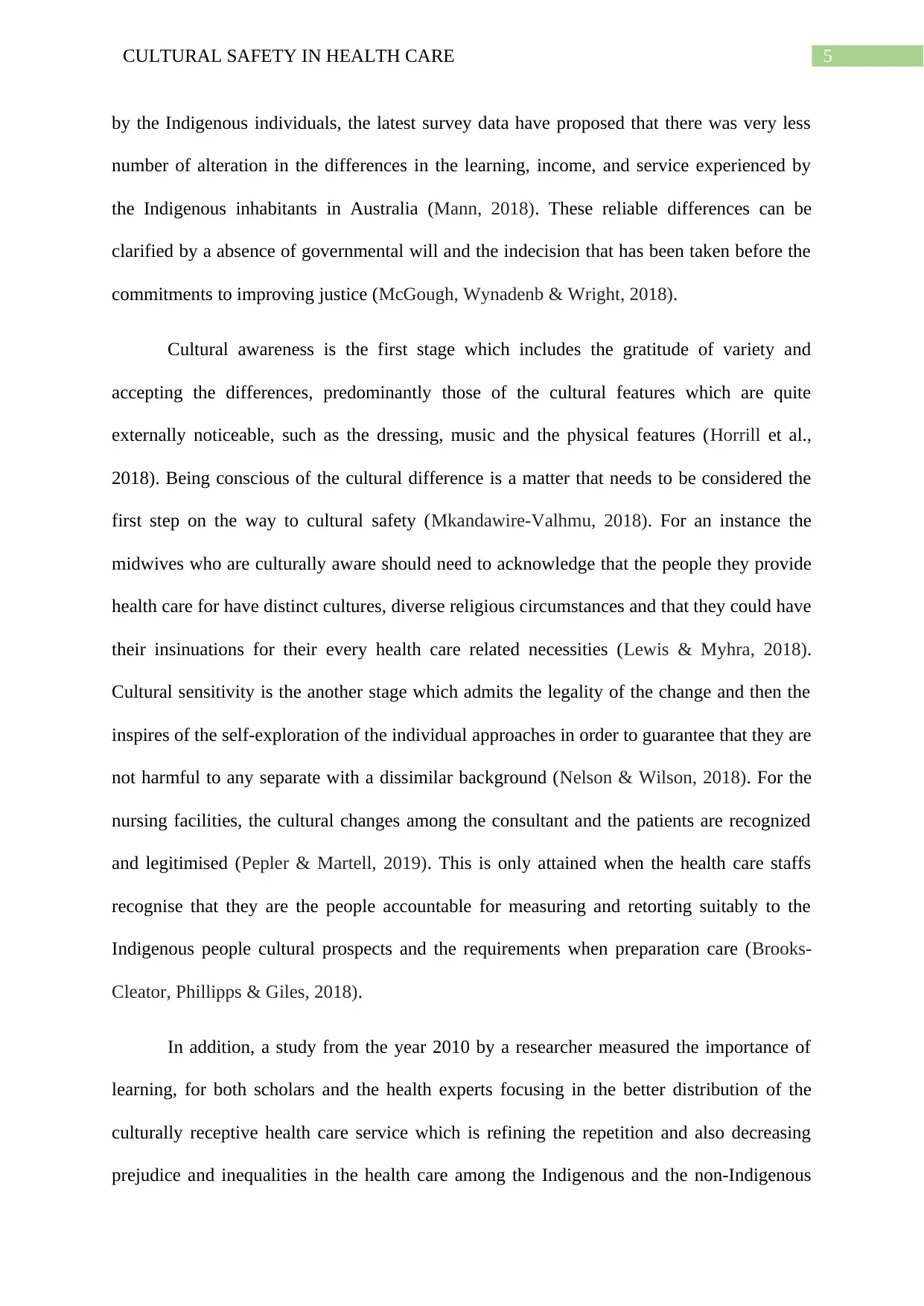
5CULTURAL SAFETY IN HEALTH CARE
by the Indigenous individuals, the latest survey data have proposed that there was very less
number of alteration in the differences in the learning, income, and service experienced by
the Indigenous inhabitants in Australia (Mann, 2018). These reliable differences can be
clarified by a absence of governmental will and the indecision that has been taken before the
commitments to improving justice (McGough, Wynadenb & Wright, 2018).
Cultural awareness is the first stage which includes the gratitude of variety and
accepting the differences, predominantly those of the cultural features which are quite
externally noticeable, such as the dressing, music and the physical features (Horrill et al.,
2018). Being conscious of the cultural difference is a matter that needs to be considered the
first step on the way to cultural safety (Mkandawire-Valhmu, 2018). For an instance the
midwives who are culturally aware should need to acknowledge that the people they provide
health care for have distinct cultures, diverse religious circumstances and that they could have
their insinuations for their every health care related necessities (Lewis & Myhra, 2018).
Cultural sensitivity is the another stage which admits the legality of the change and then the
inspires of the self-exploration of the individual approaches in order to guarantee that they are
not harmful to any separate with a dissimilar background (Nelson & Wilson, 2018). For the
nursing facilities, the cultural changes among the consultant and the patients are recognized
and legitimised (Pepler & Martell, 2019). This is only attained when the health care staffs
recognise that they are the people accountable for measuring and retorting suitably to the
Indigenous people cultural prospects and the requirements when preparation care (Brooks-
Cleator, Phillipps & Giles, 2018).
In addition, a study from the year 2010 by a researcher measured the importance of
learning, for both scholars and the health experts focusing in the better distribution of the
culturally receptive health care service which is refining the repetition and also decreasing
prejudice and inequalities in the health care among the Indigenous and the non-Indigenous
by the Indigenous individuals, the latest survey data have proposed that there was very less
number of alteration in the differences in the learning, income, and service experienced by
the Indigenous inhabitants in Australia (Mann, 2018). These reliable differences can be
clarified by a absence of governmental will and the indecision that has been taken before the
commitments to improving justice (McGough, Wynadenb & Wright, 2018).
Cultural awareness is the first stage which includes the gratitude of variety and
accepting the differences, predominantly those of the cultural features which are quite
externally noticeable, such as the dressing, music and the physical features (Horrill et al.,
2018). Being conscious of the cultural difference is a matter that needs to be considered the
first step on the way to cultural safety (Mkandawire-Valhmu, 2018). For an instance the
midwives who are culturally aware should need to acknowledge that the people they provide
health care for have distinct cultures, diverse religious circumstances and that they could have
their insinuations for their every health care related necessities (Lewis & Myhra, 2018).
Cultural sensitivity is the another stage which admits the legality of the change and then the
inspires of the self-exploration of the individual approaches in order to guarantee that they are
not harmful to any separate with a dissimilar background (Nelson & Wilson, 2018). For the
nursing facilities, the cultural changes among the consultant and the patients are recognized
and legitimised (Pepler & Martell, 2019). This is only attained when the health care staffs
recognise that they are the people accountable for measuring and retorting suitably to the
Indigenous people cultural prospects and the requirements when preparation care (Brooks-
Cleator, Phillipps & Giles, 2018).
In addition, a study from the year 2010 by a researcher measured the importance of
learning, for both scholars and the health experts focusing in the better distribution of the
culturally receptive health care service which is refining the repetition and also decreasing
prejudice and inequalities in the health care among the Indigenous and the non-Indigenous
⊘ This is a preview!⊘
Do you want full access?
Subscribe today to unlock all pages.

Trusted by 1+ million students worldwide
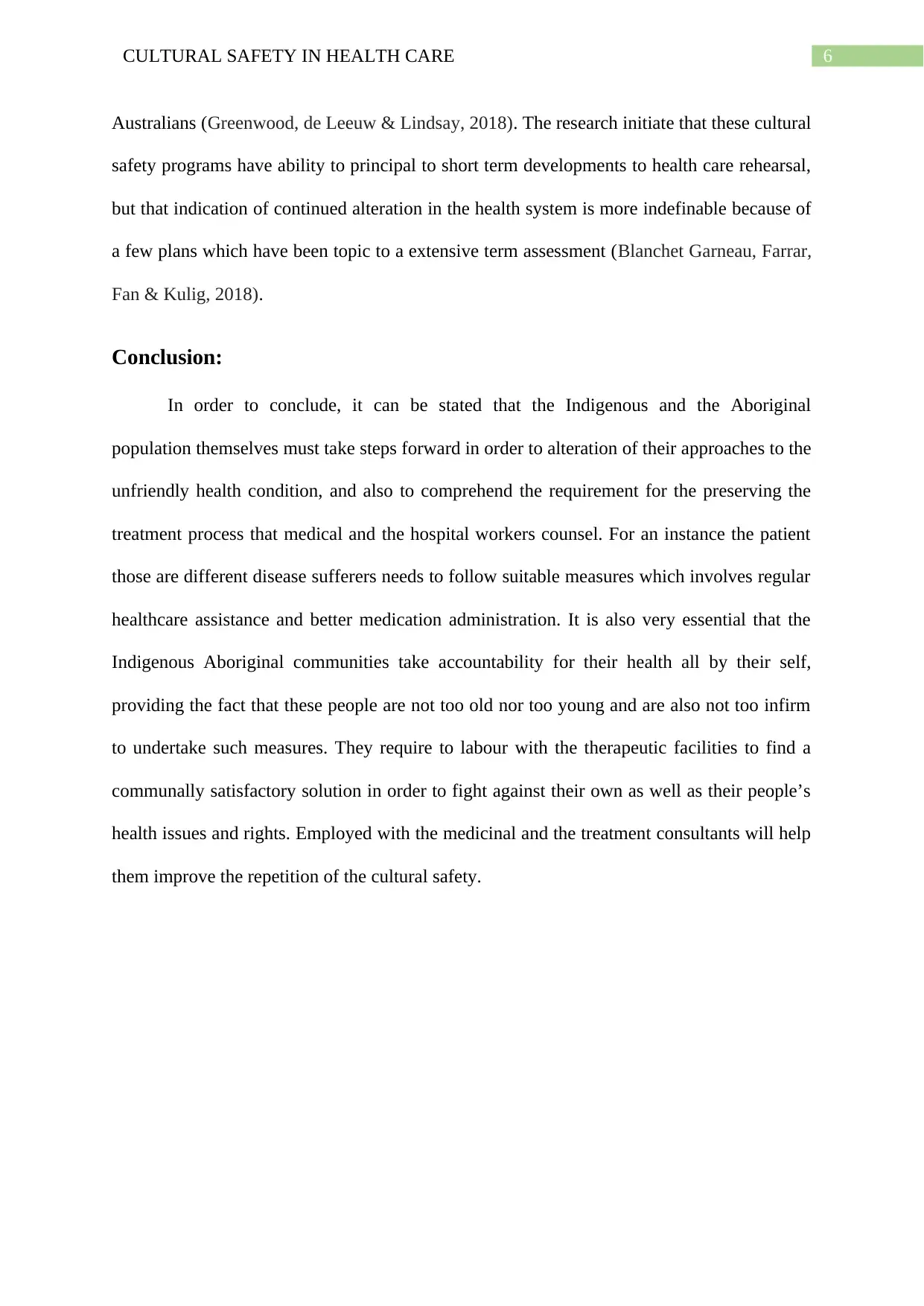
6CULTURAL SAFETY IN HEALTH CARE
Australians (Greenwood, de Leeuw & Lindsay, 2018). The research initiate that these cultural
safety programs have ability to principal to short term developments to health care rehearsal,
but that indication of continued alteration in the health system is more indefinable because of
a few plans which have been topic to a extensive term assessment (Blanchet Garneau, Farrar,
Fan & Kulig, 2018).
Conclusion:
In order to conclude, it can be stated that the Indigenous and the Aboriginal
population themselves must take steps forward in order to alteration of their approaches to the
unfriendly health condition, and also to comprehend the requirement for the preserving the
treatment process that medical and the hospital workers counsel. For an instance the patient
those are different disease sufferers needs to follow suitable measures which involves regular
healthcare assistance and better medication administration. It is also very essential that the
Indigenous Aboriginal communities take accountability for their health all by their self,
providing the fact that these people are not too old nor too young and are also not too infirm
to undertake such measures. They require to labour with the therapeutic facilities to find a
communally satisfactory solution in order to fight against their own as well as their people’s
health issues and rights. Employed with the medicinal and the treatment consultants will help
them improve the repetition of the cultural safety.
Australians (Greenwood, de Leeuw & Lindsay, 2018). The research initiate that these cultural
safety programs have ability to principal to short term developments to health care rehearsal,
but that indication of continued alteration in the health system is more indefinable because of
a few plans which have been topic to a extensive term assessment (Blanchet Garneau, Farrar,
Fan & Kulig, 2018).
Conclusion:
In order to conclude, it can be stated that the Indigenous and the Aboriginal
population themselves must take steps forward in order to alteration of their approaches to the
unfriendly health condition, and also to comprehend the requirement for the preserving the
treatment process that medical and the hospital workers counsel. For an instance the patient
those are different disease sufferers needs to follow suitable measures which involves regular
healthcare assistance and better medication administration. It is also very essential that the
Indigenous Aboriginal communities take accountability for their health all by their self,
providing the fact that these people are not too old nor too young and are also not too infirm
to undertake such measures. They require to labour with the therapeutic facilities to find a
communally satisfactory solution in order to fight against their own as well as their people’s
health issues and rights. Employed with the medicinal and the treatment consultants will help
them improve the repetition of the cultural safety.
Paraphrase This Document
Need a fresh take? Get an instant paraphrase of this document with our AI Paraphraser
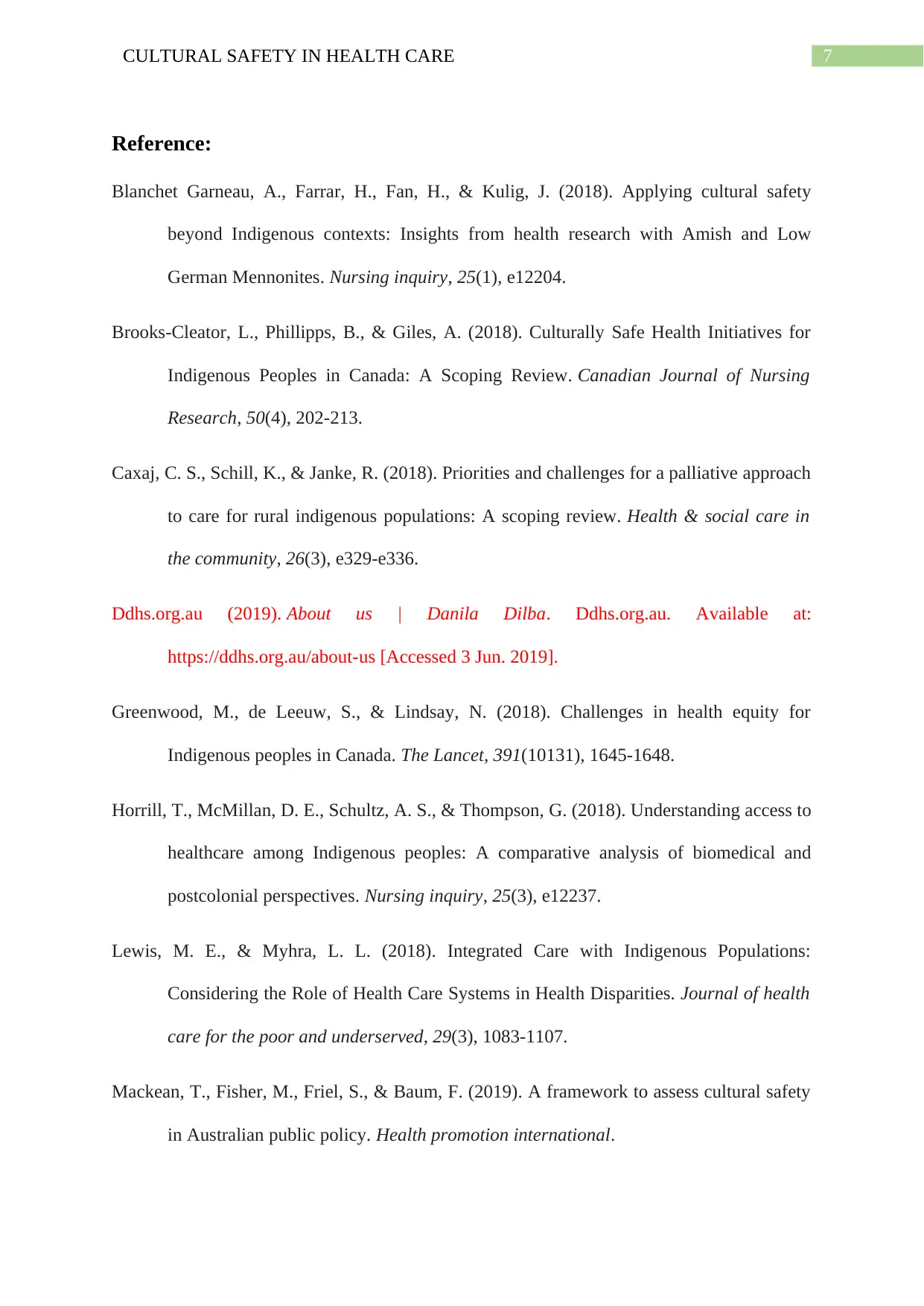
7CULTURAL SAFETY IN HEALTH CARE
Reference:
Blanchet Garneau, A., Farrar, H., Fan, H., & Kulig, J. (2018). Applying cultural safety
beyond Indigenous contexts: Insights from health research with Amish and Low
German Mennonites. Nursing inquiry, 25(1), e12204.
Brooks-Cleator, L., Phillipps, B., & Giles, A. (2018). Culturally Safe Health Initiatives for
Indigenous Peoples in Canada: A Scoping Review. Canadian Journal of Nursing
Research, 50(4), 202-213.
Caxaj, C. S., Schill, K., & Janke, R. (2018). Priorities and challenges for a palliative approach
to care for rural indigenous populations: A scoping review. Health & social care in
the community, 26(3), e329-e336.
Ddhs.org.au (2019). About us | Danila Dilba. Ddhs.org.au. Available at:
https://ddhs.org.au/about-us [Accessed 3 Jun. 2019].
Greenwood, M., de Leeuw, S., & Lindsay, N. (2018). Challenges in health equity for
Indigenous peoples in Canada. The Lancet, 391(10131), 1645-1648.
Horrill, T., McMillan, D. E., Schultz, A. S., & Thompson, G. (2018). Understanding access to
healthcare among Indigenous peoples: A comparative analysis of biomedical and
postcolonial perspectives. Nursing inquiry, 25(3), e12237.
Lewis, M. E., & Myhra, L. L. (2018). Integrated Care with Indigenous Populations:
Considering the Role of Health Care Systems in Health Disparities. Journal of health
care for the poor and underserved, 29(3), 1083-1107.
Mackean, T., Fisher, M., Friel, S., & Baum, F. (2019). A framework to assess cultural safety
in Australian public policy. Health promotion international.
Reference:
Blanchet Garneau, A., Farrar, H., Fan, H., & Kulig, J. (2018). Applying cultural safety
beyond Indigenous contexts: Insights from health research with Amish and Low
German Mennonites. Nursing inquiry, 25(1), e12204.
Brooks-Cleator, L., Phillipps, B., & Giles, A. (2018). Culturally Safe Health Initiatives for
Indigenous Peoples in Canada: A Scoping Review. Canadian Journal of Nursing
Research, 50(4), 202-213.
Caxaj, C. S., Schill, K., & Janke, R. (2018). Priorities and challenges for a palliative approach
to care for rural indigenous populations: A scoping review. Health & social care in
the community, 26(3), e329-e336.
Ddhs.org.au (2019). About us | Danila Dilba. Ddhs.org.au. Available at:
https://ddhs.org.au/about-us [Accessed 3 Jun. 2019].
Greenwood, M., de Leeuw, S., & Lindsay, N. (2018). Challenges in health equity for
Indigenous peoples in Canada. The Lancet, 391(10131), 1645-1648.
Horrill, T., McMillan, D. E., Schultz, A. S., & Thompson, G. (2018). Understanding access to
healthcare among Indigenous peoples: A comparative analysis of biomedical and
postcolonial perspectives. Nursing inquiry, 25(3), e12237.
Lewis, M. E., & Myhra, L. L. (2018). Integrated Care with Indigenous Populations:
Considering the Role of Health Care Systems in Health Disparities. Journal of health
care for the poor and underserved, 29(3), 1083-1107.
Mackean, T., Fisher, M., Friel, S., & Baum, F. (2019). A framework to assess cultural safety
in Australian public policy. Health promotion international.
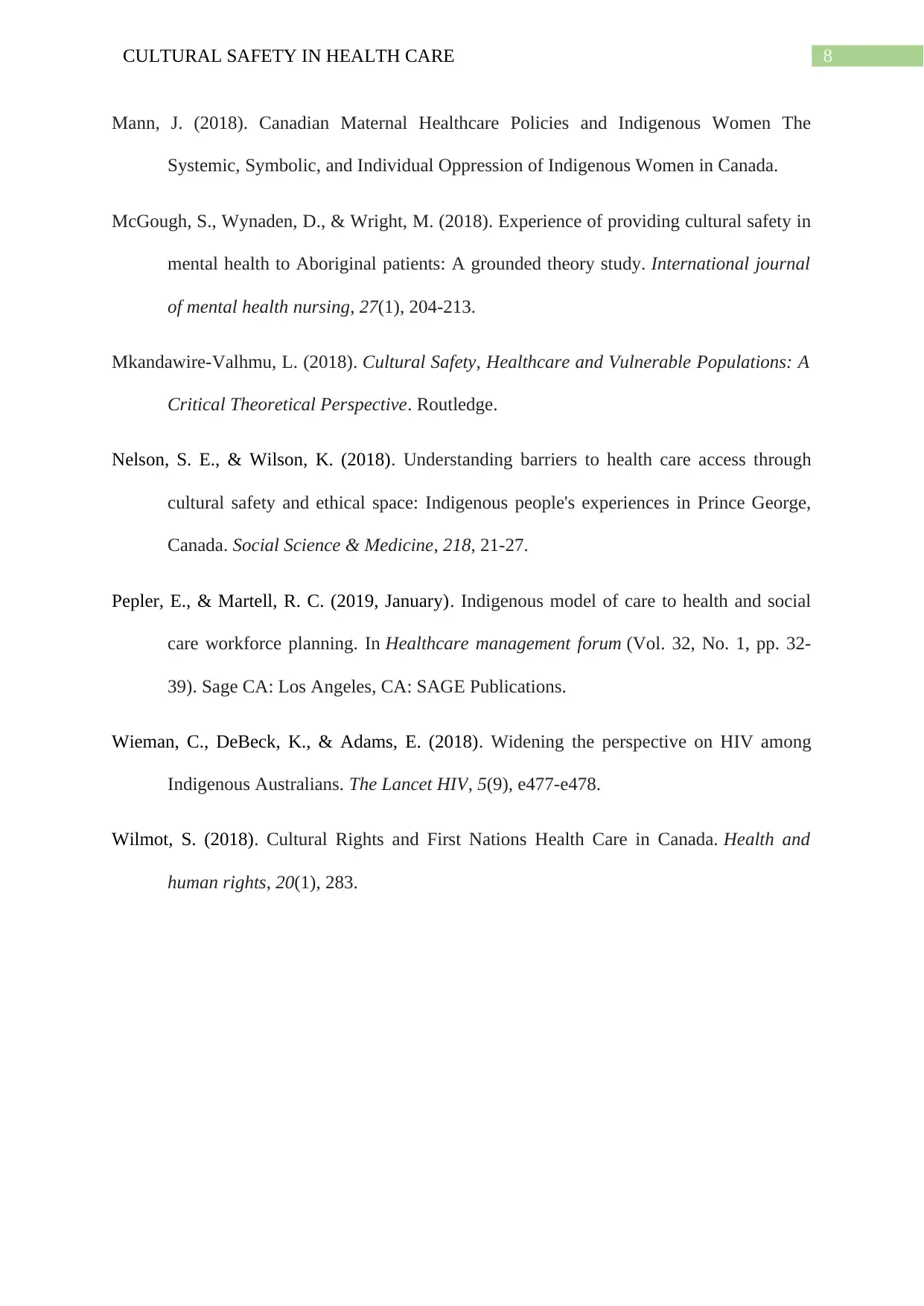
8CULTURAL SAFETY IN HEALTH CARE
Mann, J. (2018). Canadian Maternal Healthcare Policies and Indigenous Women The
Systemic, Symbolic, and Individual Oppression of Indigenous Women in Canada.
McGough, S., Wynaden, D., & Wright, M. (2018). Experience of providing cultural safety in
mental health to Aboriginal patients: A grounded theory study. International journal
of mental health nursing, 27(1), 204-213.
Mkandawire-Valhmu, L. (2018). Cultural Safety, Healthcare and Vulnerable Populations: A
Critical Theoretical Perspective. Routledge.
Nelson, S. E., & Wilson, K. (2018). Understanding barriers to health care access through
cultural safety and ethical space: Indigenous people's experiences in Prince George,
Canada. Social Science & Medicine, 218, 21-27.
Pepler, E., & Martell, R. C. (2019, January). Indigenous model of care to health and social
care workforce planning. In Healthcare management forum (Vol. 32, No. 1, pp. 32-
39). Sage CA: Los Angeles, CA: SAGE Publications.
Wieman, C., DeBeck, K., & Adams, E. (2018). Widening the perspective on HIV among
Indigenous Australians. The Lancet HIV, 5(9), e477-e478.
Wilmot, S. (2018). Cultural Rights and First Nations Health Care in Canada. Health and
human rights, 20(1), 283.
Mann, J. (2018). Canadian Maternal Healthcare Policies and Indigenous Women The
Systemic, Symbolic, and Individual Oppression of Indigenous Women in Canada.
McGough, S., Wynaden, D., & Wright, M. (2018). Experience of providing cultural safety in
mental health to Aboriginal patients: A grounded theory study. International journal
of mental health nursing, 27(1), 204-213.
Mkandawire-Valhmu, L. (2018). Cultural Safety, Healthcare and Vulnerable Populations: A
Critical Theoretical Perspective. Routledge.
Nelson, S. E., & Wilson, K. (2018). Understanding barriers to health care access through
cultural safety and ethical space: Indigenous people's experiences in Prince George,
Canada. Social Science & Medicine, 218, 21-27.
Pepler, E., & Martell, R. C. (2019, January). Indigenous model of care to health and social
care workforce planning. In Healthcare management forum (Vol. 32, No. 1, pp. 32-
39). Sage CA: Los Angeles, CA: SAGE Publications.
Wieman, C., DeBeck, K., & Adams, E. (2018). Widening the perspective on HIV among
Indigenous Australians. The Lancet HIV, 5(9), e477-e478.
Wilmot, S. (2018). Cultural Rights and First Nations Health Care in Canada. Health and
human rights, 20(1), 283.
⊘ This is a preview!⊘
Do you want full access?
Subscribe today to unlock all pages.

Trusted by 1+ million students worldwide
1 out of 9
Related Documents
Your All-in-One AI-Powered Toolkit for Academic Success.
+13062052269
info@desklib.com
Available 24*7 on WhatsApp / Email
![[object Object]](/_next/static/media/star-bottom.7253800d.svg)
Unlock your academic potential
Copyright © 2020–2025 A2Z Services. All Rights Reserved. Developed and managed by ZUCOL.





